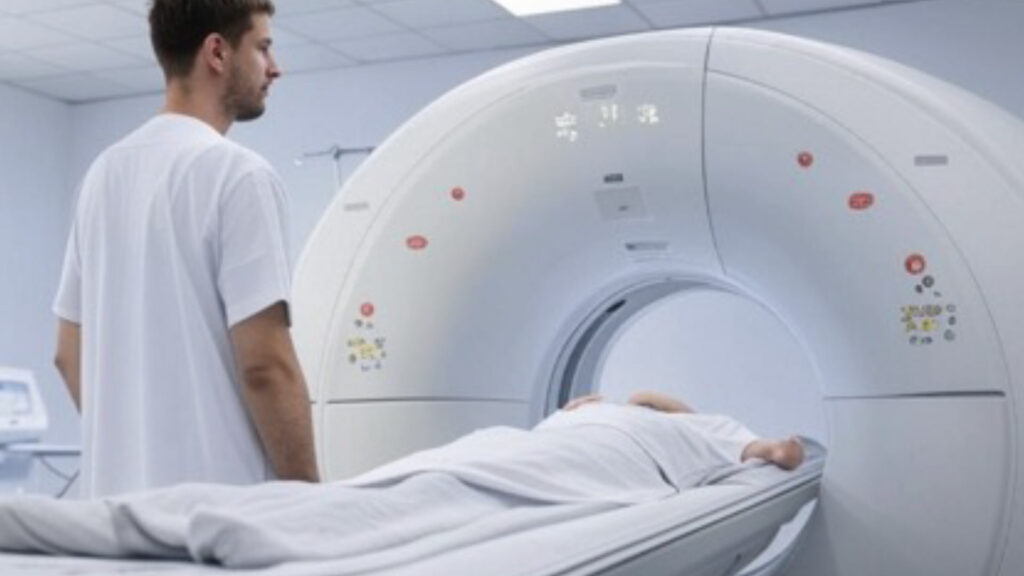The Clinical Imperative for Better Motion Imaging
In the field of radiation oncology, the ability to accurately characterize and manage tumor motion is critical for treatment precision. Yet existing imaging modalities remain imperfect. Four-dimensional computed tomography (4DCT)—the standard approach for motion management—has well-documented limitations, where the tumor’s shape and location are often misrepresented due to irregular breathing, which is common among patients with lung cancer.
At UCLA, we have clinically implemented five-dimensional computed tomography (5DCT) to overcome the inherent weaknesses of 4DCT. The new solution provides a more robust, artifact-free imaging solution by replacing retrospective phase or amplitude sorting and has been in clinic use since 2019. Consequentially, we have observed significant improvements in tumor motion characterization, target delineation, and overall confidence in treatment planning.
Why 5DCT is a Superior Imaging Modality
Unlike 4DCT, which relies on image data acquired during a single breath, lasting approximately only 8 seconds, 5DCT acquires multiple images over multiple breaths and analyzes them through a mathematical motion model to provide a motion artifact-free image and accurate representation of the tumor’s location during free-breathing. Key advantages over 4DCT include:
- Elimination of Sorting Artifacts, by avoiding the risk of phase binning errors in patients with variable breathing patterns.
- Improved Image Fidelity, with a continuous, model-based motion characterization, reducing blurring and misalignment that can occur with phase-based imaging.
- Enhanced ITV Delineation, that are often underestimated in 4DCT due to sampling errors due to its sensitivity to irregular breathing.
- Seamless Integration with Existing Workflows. 5DCT is designed to be compatible with standard CT acquisition protocols, requiring no major hardware modifications, making it an efficient and scalable solution for clinics seeking to improve motion imaging.
Clinical Experience at UCLA
Our analysis of over 300 patients imaged with 5DCT demonstrated the following:
- 82% of cases successfully utilized 5DCT-derived images for radiation therapy planning.
- In 12% of cases, a backup analysis protocol provided a clinical image set for ITV contouring and treatment planning.
- 0% of patients had to return to undergo a repeat CT simulation scan.
Expanding the Clinical Applications of 5DCT
While 5DCT has proven indispensable in lung cancer radiation therapy, our research team has already begun to evaluate its utility beyond thoracic malignancies:
- Abdominal Tumor Motion Management: Liver and pancreatic cancers pose unique motion-related challenges that 5DCT can address through superior motion characterization.
- Functional Lung Imaging: Ongoing research explores the potential of 5DCT-derived ventilation mapping to enhance functional avoidance radiation therapy, optimizing treatment plans to spare regions of high pulmonary function.
- Adaptive Radiotherapy: The model-based nature of 5DCT enables real-time adjustments in radiation dose planning, supporting the development of truly adaptive treatment strategies.
Why Institutions Should Consider Adopting 5DCT
For radiation oncology departments seeking to enhance motion imaging accuracy and treatment precision, 5DCT represents a compelling investment. The technology:
- Eliminates motion artifacts, ensuring clearer, more reliable images.
- Reduces uncertainty in target delineation, improving dose precision.
- Simple to implement, requiring no major hardware modifications.
- Expands treatment possibilities, including functional imaging and adaptive therapy.
With its proven clinical efficacy and potential for further innovation, 5DCT is well-positioned to become the new standard for motion-managed imaging in radiation oncology.
Conclusion
Motion management remains one of the most complex challenges in radiation oncology, with existing imaging solutions falling short in cases of irregular breathing patterns and tumor motion variability. The clinical implementation of 5DCT at UCLA provides a viable, artifact-free solution that addresses these shortcomings while integrating seamlessly into modern treatment planning.
Institutions invested in advancing precision medicine and improving treatment outcomes should consider 5DCT as a critical component of their imaging infrastructure. For those seeking to learn more, collaborate, or explore clinical implementation, we welcome further discussion on the future of 5DCT in precision radiation therapy.
Drew Moghanaki, MD, MPH
Radiation Oncologist
